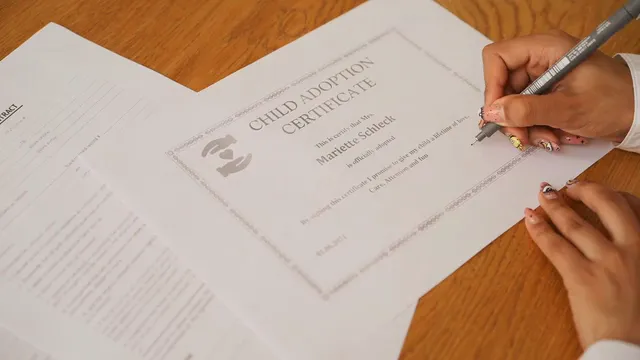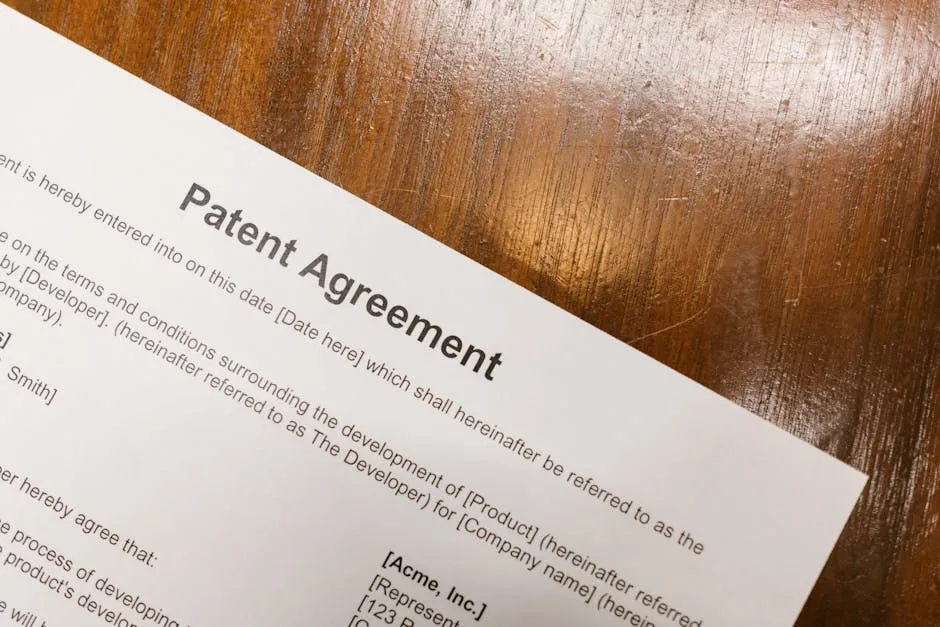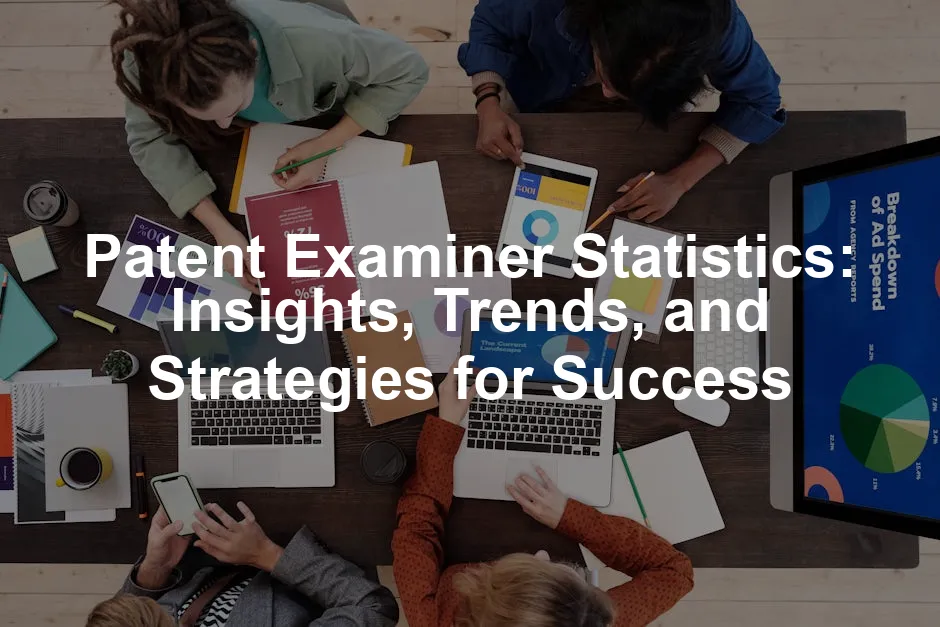Introduction
Understanding patent examiner statistics is crucial for anyone navigating the often-treacherous waters of patent applications. These statistics serve as a roadmap, guiding inventors and patent attorneys through the complexities of the approval process. Just as a sailor relies on a compass, patent professionals can use these statistics to steer their applications toward success.
The purpose of this article is to shine a spotlight on the often-overlooked realm of patent examiner statistics. We aim to provide you with insights into examiner performance, recent trends in patent approvals, and strategies to leverage this data for better outcomes. Whether you’re a seasoned patent attorney or a budding inventor, these insights will empower you to make informed decisions.
Why should you care about these statistics? Well, they can significantly impact your patent journey. For inventors, understanding examiner behavior can set realistic expectations about approval timelines and potential roadblocks. For patent attorneys, these statistics can inform strategies that lead to more effective applications. Businesses, too, can benefit by aligning their innovation strategies with the insights gleaned from examiner data.
As we journey through this article, expect a mix of humor, curiosity, and friendly guidance. Let’s embark on this enlightening adventure together, ensuring you’re well-equipped with the knowledge you need to navigate the patent application maze successfully!

Understanding Patent Examiner Statistics
What are Patent Examiner Statistics?
Patent examiner statistics encompass various data points that reveal how individual patent examiners perform during the examination process. These metrics include grant rates, average time to allowance, and the number of office actions issued. Understanding these statistics helps applicants gauge their chances of success and make informed decisions about their applications.
The data for these statistics is sourced from reputable organizations, most notably the United States Patent and Trademark Office (USPTO). The USPTO maintains detailed records of patent applications, examiner performance, and overall trends in patent examination. Additionally, third-party analytics platforms, like Patent Bots Subscription and IronCrow AI Subscription, aggregate and analyze this data to provide deeper insights into examiner behaviors and trends.
These platforms present the statistics in user-friendly formats, enabling users to access vital information without drowning in a sea of numbers. By utilizing these resources, patent professionals can gain a clearer understanding of how to approach their applications based on the specific examiner assigned to their case.
In summary, patent examiner statistics serve as a guiding star for inventors and patent attorneys alike, illuminating the path through the often murky waters of patent prosecution. Understanding these metrics is essential for developing effective strategies that align with examiner trends, ultimately leading to better outcomes for applicants.
For a deeper dive into the nuances of patent examiner statistics, check out our post on patent examiner statistics.

Key Statistics and Metrics
Grant Rates
Grant rates are a vital statistic in the patent examination process. They represent the percentage of patent applications that receive approval from examiners. Calculating grant rates involves taking the number of patents granted and dividing it by the total number of applications filed, usually within a specific timeframe. For example, a 75% grant rate means that 75 out of every 100 applications are approved. This metric helps applicants gauge the likelihood of their patent being granted based on historical data. Knowing the grant rates for specific examiners or art units can significantly influence strategy.

Average Time to Allowance
The average time to allowance varies among different types of patents and depends on numerous factors. Generally, the average time for a utility patent to receive an allowance is approximately 22.6 months. For design patents, the timeline can be shorter, often around 15 months. Factors influencing these timelines include the complexity of the invention, the specific art unit, and the workload of the examiner. Understanding these timelines can help applicants set realistic expectations and plan accordingly.

Number of Office Actions
Office actions refer to the communications from patent examiners regarding applications. On average, an application may receive two to three office actions before a decision is made. Each office action can either request additional information, raise objections, or indicate the application is allowed. The significance of this metric cannot be overstated; it provides insight into how many rounds of revisions might be necessary. A higher number of office actions could suggest a more challenging examination process, while fewer actions might indicate a straightforward path to allowance. Knowing the average number of office actions can assist in strategizing responses and managing timelines effectively.
The Importance of Patent Examiner Statistics
Why Patent Practitioners Should Care
Informed Decision Making
Patent examiner statistics are invaluable for shaping patent strategies. They help practitioners understand trends and nuances in examiner behavior, allowing for more informed decision-making. When armed with data on grant rates and average times to allowance, patent attorneys can tailor their strategies to align with the tendencies of specific examiners. This could mean choosing to amend claims or opting for a more aggressive approach. By leveraging these statistics, practitioners can sharpen their focus and increase their chances of success.

If you’re looking to dive deeper into the intricacies of patent law, consider checking out Patent Law: A Practitioner’s Guide. This book offers a comprehensive look at the patent process from the practitioner’s perspective, ensuring you’re well-equipped with the knowledge needed to navigate this complex field.
Client Management
Setting realistic client expectations is crucial in patent law. When clients have a clear understanding of what to expect based on examiner statistics, they are less likely to feel frustrated or misled. Statistics can provide a foundation for discussions about timelines, potential challenges, and the likelihood of approval. For instance, if an attorney knows that a particular examiner has a low grant rate, this insight can be shared with the client to prepare them for a potentially lengthy process. By utilizing data effectively, patent practitioners can foster transparency, trust, and stronger relationships with their clients, ultimately leading to better outcomes for everyone involved.

How Statistics Affect Patent Strategies
Claim Amendments
Statistics play a pivotal role in shaping patent strategies, especially when it comes to deciding whether to amend claims or pursue interviews with examiners. By analyzing grant rates and office action histories, patent professionals can make informed choices.
For instance, if an examiner has a low grant rate, it might raise a red flag. In such cases, amending claims could be a wise move. After all, you want your claims to glide smoothly through the examination process, not get stuck in bureaucratic quicksand.
Conversely, if the statistics indicate that an examiner typically grants claims with certain characteristics, pursuing an interview might be the best strategy. Engaging in dialogue can clarify misunderstandings and provide insights into the examiner’s reasoning. A well-timed chat can be the difference between a straightforward approval and a lengthy back-and-forth.
In short, understanding the statistics surrounding a specific examiner helps tailor strategies that maximize approval chances. It’s like having a cheat sheet for the exam—who wouldn’t want that?

Appeal Strategies
Understanding examiner statistics can also provide a roadmap for appeal strategies. If your application faces rejection, knowing the examiner’s historical performance can inform your next steps. For instance, if an examiner has a high overturn rate during appeals, it may signal an opportunity.
On the flip side, if the data shows that an examiner rarely reverses decisions, it might be prudent to rethink your appeal strategy. Instead of charging ahead, consider whether additional amendments could strengthen your case.
Moreover, statistics can help identify patterns in the types of rejections an examiner issues. By understanding these trends, patent practitioners can craft compelling arguments that directly address the examiner’s concerns.
Data-driven decision-making is essential for navigating the complex patent landscape. By leveraging examiner statistics, you can refine your approach to appeals, making it more likely to resonate with the decision-makers. After all, a well-informed strategy is your best ally in the quest for patent approval.

Analyzing Patent Examiner Performance
Individual Examiner Profiles
When it comes to analyzing patent examiner performance, accessing individual examiner statistics is crucial. Thankfully, various tools make this process straightforward and accessible.
One of the most popular resources is Patent Bots. This platform allows users to search for examiners by name and provides a wealth of information. You can see their grant rates, office action histories, and even compare their statistics to those of their peers. It’s like having a backstage pass to the world of patent examination!

Another excellent resource is IronCrow AI. This platform not only offers statistics on individual examiners but also delivers insights into their behaviors and trends. By using IronCrow AI, you can visualize data through intuitive dashboards, making it easier to interpret complex information.
Additionally, LexisNexis PatentAdvisor Subscription is another go-to tool for accessing examiner statistics. Their extension provides real-time insights directly on the USPTO websites. Imagine being able to check your examiner’s grant rate while reviewing your application—talk about efficiency!

Utilizing these resources, patent practitioners can gather essential data on examiners, enabling them to develop strategies that align with specific examiner tendencies. Accessing this information is like having a secret weapon in your patent strategy arsenal—one that can lead to better outcomes and smoother prosecution processes.
Comparison Across Different Examiners
Grant Rate Comparisons
Ever wondered why your application might feel like it’s stuck in a traffic jam? The culprit could be your examiner. Grant rates can vary widely among different patent examiners, leading to significant differences in the likelihood of approval. For example, one examiner might boast a grant rate of 95%, while another lingers at a mere 30%.

Imagine the frustration of submitting your application to the latter—it’s like taking a road trip with a driver who insists on stopping every few miles for snacks. If you find yourself assigned to a less favorable examiner, it might be time to rethink your strategy. Adjusting your claims or seeking an interview could be wise. After all, you want your application to cruise smoothly toward approval, not stall out in the review process.
Art Unit Performance
Art units play a crucial role in shaping patent approval outcomes. Each art unit specializes in different technological areas, and their performance can significantly impact your chances of obtaining a patent. For instance, if your invention falls under an art unit known for high rejection rates, you might face a tougher uphill battle.

Take, for example, Art Unit 2628, where one examiner has a dismal grant rate of 1%, while another in the same unit grants 93% of applications. This stark contrast means that knowing which examiner you’re dealing with could make or break your patent application.
Understanding the performance of various art units can help applicants gauge the likelihood of success. It’s like knowing which rollercoaster will give you the wildest ride—choose wisely, and you might just get your patent approved without any unexpected loops!

Tools and Resources for Patent Examiner Statistics
Free and Paid Resources
Overview of Tools
Navigating the labyrinth of patent examiner statistics can feel daunting. Luckily, there are several tools that make this process smoother. LexisNexis PatentAdvisor and IronCrow AI are among the most popular resources for accessing examiner statistics.
LexisNexis PatentAdvisor offers real-time insights into examiner behavior, including grant rates and average office actions. With its handy browser extension, you can access critical data directly on the USPTO’s websites. You’ll feel like a detective, piecing together clues to crack the case of your patent application.

On the flip side, IronCrow AI provides a visually intuitive dashboard that captures the past behaviors of over 10,000 examiners and 500 art units. With just a few clicks, you can uncover a treasure trove of statistics that can guide your prosecution strategy. This platform is especially useful for those looking to understand how specific examiners operate.
Both tools offer free tiers, giving you a taste of their capabilities. However, for those seeking deeper insights, paid subscriptions unlock additional features. These advanced functionalities can be the difference between a mediocre application and a standout submission that catches an examiner’s eye.
In conclusion, leveraging these resources can transform your approach to patent prosecution. By understanding the behaviors and trends of individual examiners and art units, you can make informed decisions that boost your chances of success. After all, knowledge is power, and in the world of patents, it can be the key to unlocking innovation!
Features of Leading Platforms
Comparison of Features
When it comes to patent examiner statistics, choosing the right platform is crucial. Several platforms provide valuable insights, each with its unique strengths and weaknesses.

First up, we have Patent Bots. This platform excels in user-friendly navigation. It allows you to search for examiners by name and provides a detailed overview of their grant rates and office actions. However, while it offers great accessibility, some users may find the depth of data somewhat lacking.
Next on the list is IronCrow AI. This platform boasts comprehensive dashboards that capture examiner behavior trends over time. The visualization features make understanding complex data much easier. The downside? New users might feel a bit overwhelmed by all the options, requiring a learning curve to fully utilize its capabilities.
Finally, we have LexisNexis PatentAdvisor. This tool integrates seamlessly with USPTO databases, offering real-time insights. The extension provides examiner statistics directly on the USPTO site. Unfortunately, some premium features are behind a paywall, which can limit access for those on a budget.
In summary, Patent Bots is great for beginners, IronCrow AI shines with its visual insights, and LexisNexis PatentAdvisor is superb for real-time data. Choose wisely based on your needs!
How to Leverage These Tools
Practical Application
Now that you know the tools at your disposal, how can you actually use them to your advantage? Here are some actionable tips for practitioners looking to develop effective prosecution strategies:
1. Understand Your Examiner: Use platforms like Patent Bots to familiarize yourself with your examiner’s statistics. Knowing their grant rates can help you set realistic expectations for your client.
2. Tailor Your Strategy: If your examiner has a low grant rate, consider amending your claims. A well-crafted claim could be the key to getting through the examination process without unnecessary delays.
3. Request Interviews: If IronCrow AI shows that an examiner often grants patents after interviews, don’t hesitate to schedule one. A conversation can clarify points of confusion and lead to a smoother application process.
4. Monitor Trends: Regularly check for updates on examiner statistics. Trends can change, and staying informed will allow you to pivot your strategies as needed.
By using these tools effectively, you’ll not only improve your chances of success but also strengthen your relationship with clients through informed decision-making. Now go out there and make those examiner statistics work for you!
If you want to be even more prepared, check out The Patent Examining Process: A Guide for Inventors. It’s a must-read for anyone looking to navigate the patent landscape with confidence!
Please let us know what you think about our content by leaving a comment down below!
Thank you for reading till here 🙂
All images from Pexels




